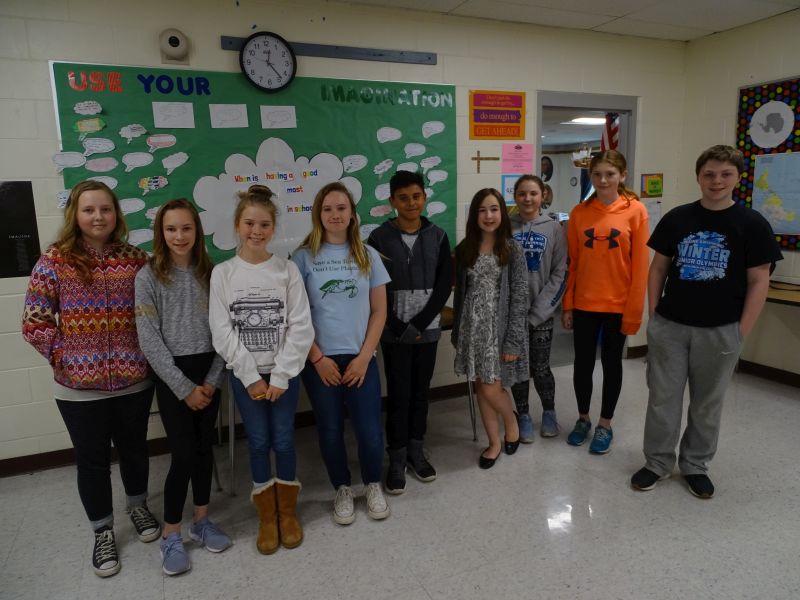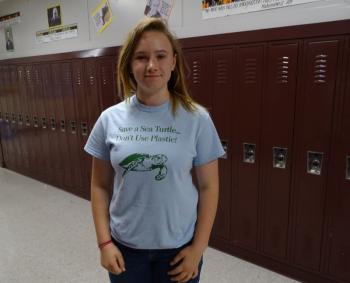Belfast middle schoolers tackle plastic pollution in schools
BELFAST — A group of industrious six graders at Troy Howard Middle School (THMS) have seen major changes in their school following their campaign to reduce the amount of plastic used and discarded by students and faculty every day.
The group, known as BRRR (Belfast Refuse, Reduce, Reuse, Recycle), got its start a couple of years ago when the student founders, Ada Curry and Marina Bannister, were finishing up their fourth-grade year, according to then-teacher Tish Manning.
Manning, who teaches at Captain Albert Stevenson School had seen an image of a sea turtle with a straw wedged deep inside of its nose shared on social media, along with a request that viewers pledge to stop using straws.
“I signed it and thought, that’s easy, I don’t ever use straws. Then the very next day I had four girls come to my room for lunch and they each had a straw in their milk cartons and I asked them why they would have a straw,” she said. Manning then showed the girls the picture of the sea turtle and told them about the pledge she had taken, saying they should also consider taking it too.
Not only did the girls take the pledge, but the following day they showed up with homemade posters telling people to stop using straws, hoping to convince their schoolmates to take the pledge too.
“I said, well if we’re going to do this we need to give people actual reasons why, and I thought it was very inspiring that they didn’t want to just themselves take the pledge.” The girls also didn’t want to focus all of their attention on straws, but rather on plastic in general. Manning said the group then busied themselves learning facts about plastics and the impact they have on the environment.
“We were just crushed that the [sea turtle] had [the straw in its nose], so we wanted to make a difference, so we started the No Straw Group and then it got switched to BRRR cause it just made more sense, co-founding six-grader Marina said. “We didn’t like that there was so much plastic in our earth and wanted to help switch all of the bad environmental stuff that was going on.”
Classmate Eliot Andrews said the group really got busy in fifth grade since there wasn’t much time left in the school year when it was founded.
“I know that it got a lot of publicity in the school and we got a chance to be on the news and it was just a really big deal once we got more people in it because, you know, if there are more people, people are going to tell their friends and it kind of just spread. In fifth grade, we got the plastic out of our cafeteria and it was really inspiring, for me anyway, when I see the way that I’m doing something is making a difference. It inspires me to keep going because I know that I’m actually helping change the world,” Andrews said.
During their fifth-grade year members of BRRR, which had grown substantially in size, met with RSU 71 District Food Service Director Perley Martin about their concerns and CASS ultimately changed from using plastic utensils every day to going back to metal utensils as a result of the meeting.
“I was invited to several meetings and they had shared with me a lot of research and so forth and it was quite an eye-opening vision and concern and I knew at the time that the food service was a big contributor of plastic and so forth, as are other food service establishments,” Martin said. “So you know, I’ve been very proactive about all of this and have been all ears. I wanted to make a difference and wanted to support the kids. I knew I could make a difference, so at that time we started reducing plastic silverware, replacing it with real silverware.”
Martin said that when he started at THMS in 1999 he moved the school to plastic silverware because it was cheaper, “I saved on labor… you know, [it was] just a way to reduce my budget and I think everybody was doing that at the time. So now here we are, 15, 20 years later, and we’re making changes again,” he said.
Martin said he can’t see a circumstance where the school system would return to plasticware given its environmental cost.
Metal silverware has also replaced plasticware at THMS, Belfast Area High School, and all other SAD 71 schools, according to Martin.
When the students moved from CASS to THMS, Manning knew that she would need to find a fellow teacher willing to helm the group there. Fortunately, Manning remained good friends with a former CASS teacher and current middle-school teacher, Martha Conway-Cole, who was happy to take over the group over the summer and once they made their middle school transition.
THMS students raised money for the silverware by using two school dances as fundraisers. For a while the Parent Teacher Group were making regular donations, though Martin said now that he is buying the silverware, he wants fundraising money to be used elsewhere.
The changes at THMS were made relatively soon, just two or three months after the arrival of the BRRR kids, who have continued to expand their numbers in middle school to roughly 20.
Plastic items that have been removed from the school food programs include plastic baggies, cups, silverware, and straws, among others.
Conway-Cole said she had recently done the math and that this year alone THMS was able to save 40,000 pieces of plastic from being used and discarded. The changes made at CASS have saved an estimated 69,200 pieces of plasticware and 70,000 plastic baggies this year alone, making the total number of plastic pieces saved by both schools over 170,000.
Not content with just changing their school and school district, the BRRR kids also said that they try to refuse and reduce their plastic consumption when out of school too, though both Marina and Eliot noted it can be difficult to avoid plastics in supermarkets.
When asked what they wish more people knew about plastics and other non-biodegradable products’ impact on the environment, there was no shortage of replies.
“It was hurting the environment a lot more than it seemed, like a piece of plastic from here could end up all across the world, Tanner Carson said.
“And when people are using paper instead of plastic and using alternatives, they’re really making a difference instead of using plastic. Some people don’t know how much of a difference it makes, but it makes a pretty big difference, Ada added.
For Sophia Taylor, the potential impact on the food chain is also a major concern. “If one species goes extinct in the fish, then the rest of the chain is just going to fall apart and eventually we won’t have fish to eat and other animals in the ocean, and fish are going to die off and then the ocean is just going to be full of plastic,” she said.
Ada said the idea of people eating fish that have ingested plastic is also concerning, “we don’t know the effects that plastic has on our body, so that’s kind of scary, eating plastic.”
All the BRRR kids were pleased with Belfast’s plastic bag ban, which went into effect in January.
“I think everyone in Belfast has kind of gotten used to the fact that we don’t have [plastic] bags anymore in the stores, and when I got to Camden or Rockland [or] any other town, it’s kind of weird going into a grocery store and seeing all those plastic bags. It kind of makes me think, maybe we could find a way to get them to stop,” Sophia said.
For her part, Conway-Cole said she couldn’t be prouder of her students and that the process has been “a real education for me, because they came in knowing more than I did,” she said.
Once Conway-Cole started looking into the research she said she realized there were “so many places where we could be reducing the amount of plastic we’re throwing out every day.”
“We did the math and realized [THMS] were throwing away 40,000 pieces of plastic every year,” she said of the impact, while Manning says CASS has saved over 4,000 straws from being thrown away in the last four weeks.
The sixth-grade class also had the chance to watch the film Smog of the Sea, which is a Camden filmmakers chronicle of a week-long trip through the “remote waters of the Sargasso Sea,” where one large garbage patch is located. They also hosted visits from the Belfast Bay Watershed Coalition, Upstream, and Northport Elementary School, who brought along their research about the plastics they’re finding in Penobscot Bay.
Conway-Cole said Northport Elementary’s research really hit home with the student because it provided them with compelling evidence that [plastics] are affecting our own ecosystem.
“We also went on a field trip to the Maine Environmental Research Institute in Blue Hill and they are sort of the foremost researchers in microplastics in Penobscot Bay, and we collected the water right there, took it in and looked at it under a microscope and found microplastics,” she said.
According to Earth Day Network, about eight million metric tons of plastic are thrown into the ocean annually, and 236,000 of those tons are composed of microplastics, which are tiny bits of broken down plastic that can be smaller than a pinky nail. This has led to five enormous patches of plastic in oceans around the world, with one located between California and Hawaii currently the size of the state of Texas. The amount of plastic in the ocean is set to increase tenfold by 2020, and by 2050 it is expected there will be more plastic in the oceans that fish (by weight).
Plastic is frequently ingested by sea animals, with millions of birds and fish killed each year, along with 100,000 marine mammals. All are unable to differentiate plastic from their usual food sources, though animals don’t have to ingest plastics to be negatively impacted by them. The likelihood that coral will become diseased increases from four percent to 89 percent if it comes into contact with marine plastic, which has been found at 36,000 feet below, at the bottom of the Mariana Trench, the deepest part of the ocean.
While the problem with plastics in the environment is an enormous one, Manning said one thing she impressed upon the kids is to present solutions to those problems, rather than just stating the problem itself. The kids did just that in two short videos they created for the Sears Island Science Square program, which are featured on the Friends of Sears Island Facebook page.
Some of the suggested solutions include stopping the use of plastic, refusing straws, using metal silverware rather than plastic, and picking up plastic litter that you see on beaches or elsewhere.
“I always have the kids say what the solutions are, actions we can take so that we don’t dwell on the problems, we really focus on, just do stuff. Don’t just hear the information and walk by. Make change and an effort,” Manning said.





























